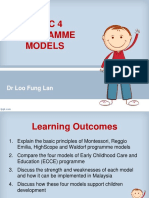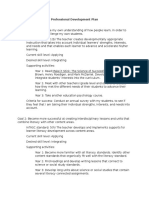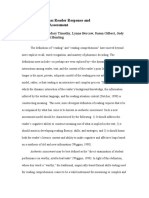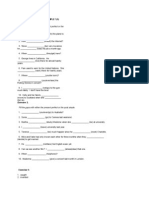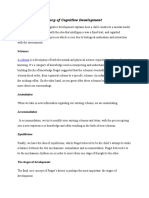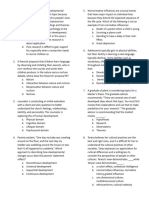Clep Educational Psychology Questions
Clep Educational Psychology Questions
Uploaded by
Ha AutumnCopyright:
Available Formats
Clep Educational Psychology Questions
Clep Educational Psychology Questions
Uploaded by
Ha AutumnOriginal Title
Copyright
Available Formats
Share this document
Did you find this document useful?
Is this content inappropriate?
Copyright:
Available Formats
Clep Educational Psychology Questions
Clep Educational Psychology Questions
Uploaded by
Ha AutumnCopyright:
Available Formats
CLEP Educational Psychology
Practice Test
Time90 Minutes For each question below, choose the best answer from the
100 Questions choices given.
1. Which of the following would NOT typically be 4. It has been suggested that every successful
included in the things to consider when planning teaching encounter could be analyzed in terms
how a teacher would approach a particular of the
lesson?
(A) actions of the students
(A) The unique individual and normative (B) artistic application of theory and research
characteristics of the students (C) instinct of the teacher
(B) The mission of the school (D) outcomes achieved
(C) The curriculum and the level of complexity (E) intentions of those involved
desired
(D) The students previous learning 5. Educational research
(E) District test scores
(A) supports a common sense approach to
decision-making
2. A study that identifies whether two variables are
(B) has provided little insight into the art of
related, while not telling us if one causes the
teaching
other, would be a
(C) has challenged a number of common sense
(A) correlational study approaches to teaching
(B) descriptive study (D) has little value given the artistry of
(C) naturalistic study effective teaching
(D) quasi experimental study (E) is less valid when compared to other scien-
(E) clinical study tific research
3. Which of the following is true about the process 6. The process of making new information more
of teaching? meaningful by relating it to something already
known is
(A) Teaching can be non-relational.
(B) Teaching can be a passive as well as an (A) mnemonic
active process. (B) rehearsal
(C) Teaching can occur without interaction. (C) elaboration
(D) Teaching is an intentional, goal-directed (D) exposition
process. (E) expansion
(E) None of the above is true.
Copyright 2004 Thomson Petersons, CLEP is a registered trademark of the College Entrance Examination Board,
part of The Thomson Corporation which was not involved in the production of and does not endorse this product.
CLEP-Ed-psyc-P2.pmd 1 4/4/2005, 12:12 PM
CLEP EDUCATIONAL PSYCHOLOGY PRACTICE TEST
7. The process of interpreting and attaching mean- 11. When cognitive theorists speak of storage they
ing to an experience is called are generally referring to
(A) perception (A) assimilating
(B) encoding (B) accommodating
(C) elaboration (C) encoding into memory
(D) chunking (D) creating subfiles
(E) labeling (E) stacking
8. After having your picture taken with a flash 12. The fact that we may remember the items in the
camera, you see circles of light. This experi- beginning of a list faster than those in the middle
ence is most likely related to of the list may be explained by
(A) the sensory register (A) the recency effect
(B) encoding (B) fatigue
(C) neural spikes (C) the primacy effect
(D) attention (D) the ordinal effect
(E) STM (E) the initiation effect
9. A teacher who attempts to facilitate learning by 13. A student who has memories of general facts and
adapting a presentation to the way a student tries concepts would be said to have
to facilitate his or her own learning is employing (A) didactic knowledge
(A) the mathemagenic factor (B) process knowledge
(B) advanced organizers (C) semantic memory
(C) scaffolds (D) eidetic memory
(D) mediators (E) event memory
(E) the dual stage theory
10. Sheila decided to cook dessert for Thanksgiving. 14. Which of the following would be an example of
She is a little nervous, so she rehearses what she maintenance rehearsal?
should do first, then the next step, then the next (A) Connecting new material to old
stepall the way to the last step. Sheila is (B) Attempting to create examples of the new
strengthening her material
(A) procedural memory (C) Repeating the information over and over
(B) episodic memory again
(C) semantic memory (D) Attempting to personalize the material
(D) event memory (E) Using mnemonic devices
(E) ritual memory
Copyright 2004 Thomson Petersons, CLEP is a registered trademark of the College Entrance Examination Board,
part of The Thomson Corporation which was not involved in the production of and does not endorse this product.
CLEP-Ed-psyc-P2.pmd 2 4/4/2005, 12:12 PM
CLEP EDUCATIONAL PSYCHOLOGY PRACTICE TEST
15. All students are listening to the teachers riveting 18. Ralph attempts to remember the names of all his
lecture when suddenly a loud, sudden noise students by connecting their first name to a unique
occurs in the back of the room. The students all physical feature. Therefore, Fred has freckles,
startle and turn away from the teacher to look to Louise has large lips, and Sidney wears spec-
the back of the room. The reaction is a result of tacles. Ralph is employing which of the following
the work of techniques to facilitate long term storage?
(A) sensory register (A) Elaboration rehearsal
(B) sensory gating (B) Maintenance rehearsal
(C) survival instinct (C) Sensory registering
(D) short-term encoding (D) Chunking
(E) the reticular activating system (E) Mnemonics
16. Cognitive learning theorists seem to emphasize 19. Under which of the following conditions can
the importance of attention in the learning inhibition or interference occur?
process. From the three-component model of
(A) When the old and new learning concepts are
memory, why is attention so important?
very similar
(A) It helps information record to the sensory (B) When the old and new learning concepts are
register the exact opposite
(B) It facilitates information moving from (C) When the old and new learning concepts are
sensory register to working memory very dissimilar
(C) It is required to encode into long-term (D) When the new and old learning concepts are
memory taught at the same time
(D) Without it, proactive interference will occur. (E) When two concepts are learned in the same
(E) Without it, retroactive interference will way
occur
20. Richard can give you a step by step account of
17. The process of grouping information so as to the game last Friday. He can describe the
increase the storage capacity of the working various plays and the players reactions. Richard
memory is called has a good
(A) elaboration rehearsal (A) episodic memory
(B) maintenance rehearsal (B) procedural memory
(C) mnemonics (C) semantic memory
(D) chunking (D) athletic memory
(E) whittling (E) visual reporting memory
21. Operant conditioning is associated with which
concept of learning?
(A) The law of contiguity
(B) The law of confluence
(C) The law of primacy
(D) The law of association
(E) The law of effect
Copyright 2004 Thomson Petersons, CLEP is a registered trademark of the College Entrance Examination Board,
part of The Thomson Corporation which was not involved in the production of and does not endorse this product.
CLEP-Ed-psyc-P2.pmd 3 4/4/2005, 12:12 PM
CLEP EDUCATIONAL PSYCHOLOGY PRACTICE TEST
22. If a conditioned stimulus is presented in the 27. Which of the following would most likely have
absence of an unconditioned stimulus, ______ been a learned response as a result of classical
may occur. conditioning?
(A) discrimination (A) Jumping upon hearing a loud, sudden noise
(B) extinction (B) Raising your hand in class to ask a question
(C) resistance (C) Feeling anxious near snakes
(D) spontaneous recovery (D) Taking out the trash for your parents
(E) generalization (E) Working for a paycheck
23. Using a higher frequency behavior as a reinforcer 28. Even though Tania was terrified of her male
for a less frequent behavior is an example of
teacher last year, she entered her new classroom
(A) the contiguity principle this year calm and unafraid, even though she had
(B) the Premack principle another male as a teacher. Tania appears to be
(C) the principle of primacy demonstrating
(D) shaping
(E) secondary gains (A) stimulus reversal
(B) discrimination
(C) undergeneralization
24. An intermittent reinforcement schedule delivers
(D) differential reinforcement
reinforcement
(E) fading
(A) continuously
(B) some of the time
29. Mr. Spradlin decides to give students the oppor-
(C) in bursts
tunity to earn homework passes that allow them
(D) at the request of the subject
(E) that is non-contingent to skip doing homework for one night. Assum-
ing that not doing homework increases student
performance, not doing homework would be
25. Stickers, teachers words of praise, and small gifts considered
(A) are positive reinforcers (A) negative reinforcement
(B) are negative reinforcers (B) primary reinforcement
(C) may be reinforcers, depending on the effect (C) positive reinforcement
they have (D) chained reinforcement
(D) may be reinforcers, depending on the setting (E) hierarchical reinforcement
(E) may be reinforcers, depending on the timing
30. A behavior that is reinforced on a(n) _________
26. While behaviorists may differ on specifics about schedule of reinforcement is most resistant to
how learning occurs, they agree on emphasizing extinction.
the
(A) continuous
(A) importance of rewards
(B) intermittent
(B) power of individual choice
(C) reciprocal
(C) role that thinking plays in processing
(D) circular
information
(D) importance of the environment on learning (E) graduated
(E) importance of the dualphase model of
learning
Copyright 2004 Thomson Petersons, CLEP is a registered trademark of the College Entrance Examination Board,
part of The Thomson Corporation which was not involved in the production of and does not endorse this product.
CLEP-Ed-psyc-P2.pmd 4 4/4/2005, 12:12 PM
CLEP EDUCATIONAL PSYCHOLOGY PRACTICE TEST
31. Which of the following is the best example of an 35. According to Piagetian theory, which of the
intrinsic reinforcement? following concepts is LEAST related to the other
four?
(A) Getting a certificate stating that you are an
outstanding student (A) Adaptation
(B) Being able to play Nintendo after doing all (B) Assimilation
of your homework (C) Accommodation
(C) Being praised for answering the questions (D) Schema
(D) Feeling good about completing a major (E) Disequilibrium
project
(E) Feeling good about pleasing the teacher 36. A child listens to his mother say the word dog
and tries to imitate the sound his mother makes.
32. The fact that a child in the pre-operational stage This would illustrate which of the following
of development tends to focus on one perceptual theories of language development?
aspect of an event to the exclusion of others
(A) Biological
demonstrates
(B) Psychoanalytic
(A) centration (C) Constructive
(B) transductive logic (D) Social learning
(C) egocentrism (E) Phonetic
(D) seriation
(E) primal thinking 37. Developmental theorists generally agree that
development
33. For Vygotsky, which of the following concepts
(A) is sequential
appears central to learning?
(B) is completely unique to each individual
(A) Disequilibrium (C) is sporadic
(B) Adaptation (D) tends to be unpredictable
(C) Culture and language (E) is solely a function of genetics
(D) Proximity
(E) Assimilation 38. Which of the following would Piaget posit is
important for cognitive development?
34. When confronted with a little man with a mus-
(A) Interaction with the physical environment
tache, Howard declared: Look mom, a baby
(B) Conditioning
with a mustache! Howard is illustrating
(C) Social modeling
(A) stimulus dominance (D) Reinforcement
(B) assimilation (E) Shaping
(C) transductive logic
(D) object permanence 39. For Piaget, a pattern of organization of similar
(E) accommodation thoughts and actions would be considered
(A) a schema
(B) a neuralnet
(C) accommodation
(D) a gestalt
(E) a scan
Copyright 2004 Thomson Petersons, CLEP is a registered trademark of the College Entrance Examination Board,
part of The Thomson Corporation which was not involved in the production of and does not endorse this product.
CLEP-Ed-psyc-P2.pmd 5 4/4/2005, 12:12 PM
CLEP EDUCATIONAL PSYCHOLOGY PRACTICE TEST
40. Which of the following would illustrate the 44. Self-imposed starvation in which the individual
concept of transductive reasoning? refuses to eat or eats practically nothing is termed
(A) A pound of feathers and a pound of lead (A) bulimia
weigh the same. (B) self-denial
(B) Steam is just another form of water. (C) dysmorphia
(C) 1+1=2 and, therefore, 2-1=1. (D) analeptia
(D) If all men reason and John is a man, then (E) anorexia
John can reason.
(E) It is dark at nighttime because I am going to 45. Maria knows she can have unprotected sex with
sleep. her boyfriend because nothing will happen.
Maria believes that she and Carlos will get
41. Assimilation and accommodation both reflect married, that they will have a wonderful house
(A) imaginal manipulation and family, and that their love will keep them
(B) formal operations protected from all harm. This is an example of
(C) the use of elaboration (A) overinclusive thinking
(D) a need to resolve cognitive disequilibrium (B) imaginary audience
(E) mental operations used to move items from (C) assimilation
working memory (D) personal fable
(E) conventional morality
42. Gilligans model based moral decision making
on the morality of 46. A child in Kohlbergs pre-conventional stage of
(A) justice moral development would most likely define
(B) economy right and wrong based on:
(C) equality (A) what Mom and Dad say
(D) care (B) what the Bible says
(E) power (C) what any adult authority says
(D) what the consequences feel like
43. Timothy thought he should invite Howard to his (E) what peers do
party because Howard had invited him to his
party. However, he did not think he needed to 47. The need to excel in learning tasks while balanc-
invite Ed, since Ed didnt invite him. Timothy ing the need to avoid failure is
appears to be operating from which of the
following moral orientations (A) attribution need
(B) aesthetic need
(A) Punishment-obedience (C) competitive need
(B) Instrumental relativism (D) completedness need
(C) Interpersonal-concordance (E) achievement need
(D) Law and duty
(E) Market exchange
Copyright 2004 Thomson Petersons, CLEP is a registered trademark of the College Entrance Examination Board,
part of The Thomson Corporation which was not involved in the production of and does not endorse this product.
CLEP-Ed-psyc-P2.pmd 6 4/4/2005, 12:12 PM
CLEP EDUCATIONAL PSYCHOLOGY PRACTICE TEST
48. A student with an internal locus of control would 53. Ms. Johnson explains that she teaches, simply
most likely attribute his/her success on a task to because she loves itit is what she was meant to
(A) luck do. According to Maslow, Ms. Johnson appears
(B) effort to teach as a result of
(C) the tasks difficulty (A) the need for security
(D) the fairness of the teacher (B) the need for belongingness
(E) None of the above (C) the need for self-esteem
(D) the need for self-actualization
49. When students have multiple needs operating at (E) the need for aesthetics
one time, Maslow would suggest that the stu-
dents will
54. Rudy failed his history test. Rudy attributes his
(A) attempt to meet all of the needs simulta- failure to internal, stable factors. Which of the
neously following would most likely be Rudys explanation?
(B) select their favorite need to satisfy first
(C) respond to the need most easily met (A) It is unfair. The test was too hard.
(D) respond to a hierarchy and priority of (B) I did the best I couldIm just not good
human needs when it comes to history.
(E) respond impulsively (C) Gosh! I should have guessed more.
(D) I changed all of the answerstalk about
50. A primary need is poor luck.
(E) I should have cheated.
(A) one currently active
(B) one of the needs experienced in infancy and
early childhood 55. Ms. Leahman noted that when she starts to ask
(C) necessary for survival students pop questions, Timothy always does
(D) a growth need things to avoid eye contact. For example,
(E) one that an individual values most Timothy may slump behind the student in front
of him or pretend to be looking for something in
his book. Timothy is mostly likely
51. Research shows that high achievers typically
attribute success to (A) a mastery-oriented student
(A) internal causes (B) a failure-avoidant student
(B) external causes (C) a failure-accepting student
(C) varying causes (D) a self-efficacious student
(D) Attribution depends on the subject. (E) a self-protective student
(E) Attribution varies from person to person.
56. Students who prefer tasks that are challenging
52. Which of the following would best illustrate an and that, while requiring effort, are within their
extrinsic motivation? ability level and thus most often achievable,
would most likely be
(A) Reading for personal pleasure
(B) Enjoying playing basketball (A) external-locus control
(C) Selling subscriptions to win a trip (B) failure-avoidant
(D) Building a house because of the personal (C) high achievers
satisfaction it gives you (D) academic strivers
(E) Sleeping after an exhaustive day (E) mastery-oriented
Copyright 2004 Thomson Petersons, CLEP is a registered trademark of the College Entrance Examination Board,
part of The Thomson Corporation which was not involved in the production of and does not endorse this product.
CLEP-Ed-psyc-P2.pmd 7 4/4/2005, 12:12 PM
CLEP EDUCATIONAL PSYCHOLOGY PRACTICE TEST
57. Bill has been identified as a very charismatic 61. The most common form of word fluency disor-
individual. He can often persuade classmates to der is
follow him and participate in the things he feels
(A) stuttering
should be accomplished at school. Some have
(B) echolalia
called him a natural leader. According to Gardners
(C) dyslexia
theory of multiple intelligences, Bill has
(D) stagnation
(A) intrapersonal strengths (E) dysnomia
(B) interpersonal strengths
(C) political strengths 62. Richard has a learning disability. His school
(D) social strengths provides individualized instruction in a resource
(E) Machiavellian abilities room throughout most of the day but allows
Richard to attend his third grade for afternoon
58. Which of the following theorists believed in a activities, such as physical education, home
structure of the intellect that involved three economics and art. This is an example of
dimensions: operations, content, and product?
(A) mainstreaming
(A) Wechsler (B) inclusion
(B) Sternberg (C) partial service
(C) Guilford (D) IDEA
(D) Gardner (E) HUD
(E) Piaget
63. Which of the following guarantees that students
59. IQ, in the Stanford-Binet formulation, is found by
with cognitive, emotional, and physical disabili-
(A) dividing mental age by chronological age ties will receive an appropriate education and it
and multiplying by 100 outlines educational policies for that purpose?
(B) dividing chronological age by mental age
(A) IDEA
and multiplying by 100
(B) HUD
(C) dividing biological age by chronological age
(C) PL-94-198
and multiplying by 100
(D) Freedom of Choice Bill
(D) totaling the number of correct answers on
(E) HIPPA bill
the test
(E) taking the chronological age and multiply-
ing it by the number of questions answered 64. Which of the following is NOT typically found
correctly in students IEP?
(A) A statement of educational goals
60. A complex of neurological disabilities that (B) A statement of intended strategies or
inhibit symbol recognition and the orderly activities to be used to assist the child to
processing and assimilation of language is achieve goals
(C) A timeline for goal achievement
(A) symbol intrusion
(D) The students present level of functioning
(B) dysnomia
(E) A plan for increasing the childs IQ
(C) dyslexia
(D) symbol reversal
(E) dysparnia
Copyright 2004 Thomson Petersons, CLEP is a registered trademark of the College Entrance Examination Board,
part of The Thomson Corporation which was not involved in the production of and does not endorse this product.
CLEP-Ed-psyc-P2.pmd 8 4/4/2005, 12:12 PM
CLEP EDUCATIONAL PSYCHOLOGY PRACTICE TEST
65. Henry has been identified as having a superior 68. A teacher who is sensitive about the nature of the
intelligence. Assuming a g factor approach to posters she displays in her class and is concerned
intelligence (Spearman), which of the following that the posters reflect all of her students
would not apply? experiences is adapting curriculum through
attention to
(A) Henrys teachers report that Henry masters
their class material quite easily and quickly. (A) content
(B) Henry generally does average work in (B) context
school except in the areas of math and (C) modality
science. (D) ecology
(C) Henry is not only book-smart, but also (E) domain
shows good adaptive skills.
(D) Henry has consistently performed well 69. Which of the following is true?
throughout his school years.
(E) Henry appears to be superior to his peers in (A) Research shows no real difference in
many areas. achievement scores of children from upper
(socioeconomic status) SES families when
compared to those of lower SES.
66. Which of the following theories would suggest
(B) Research shows that children from upper
most children are intelligent in one way or
SES drop out with the same frequency as
another?
students with lower SES.
(A) Spearmans g-factor (C) There are positive correlations between low
(B) Gardners multiple intelligences SES and lower self-esteem, ability, and/or
(C) Guilfords structure of intellect readiness.
(D) Binets mental age theory (D) SES appears to be less predictive of a
(E) Wechslers deviation model students readiness than originally thought.
(E) SES seems highly predictive of school
67. Which of the following is a model of success for boys, but not for girls.
multicultural education in which students learn
about the contributions and characteristics of 70. Approaches that start with the language the
many different cultures via the use of student brings to the classroom and builds on
multicultural literature, multi-linguistics, diverse family and cultural language to promote standard
resources, and people? language usage are considered
(A) Transformative Multicultural model (A) multi-lingual
(B) Human Relations model (B) immersion
(C) Single Case model (C) transitional
(D) Melting Pot model (D) balanced
(E) Blender model (E) familial
Copyright 2004 Thomson Petersons, CLEP is a registered trademark of the College Entrance Examination Board,
part of The Thomson Corporation which was not involved in the production of and does not endorse this product.
CLEP-Ed-psyc-P2.pmd 9 4/4/2005, 12:12 PM
CLEP EDUCATIONAL PSYCHOLOGY PRACTICE TEST
71. A teacher attempting to employ multicultural 75. Teachers often need assessment that compares a
education would students performance to a specific, well-defined
(A) make sure to gather a diverse student content domain. If this is the case, they would
population for the classroom employ
(B) be sure to celebrate the holidays of only one (A) norm-referenced testing
of the major cultures in the classroom (B) formative assessment
(C) consider the perspectives of different (C) criterion-referenced testing
cultural groups throughout the year (D) Any of the above; it would depend on the
(D) devote modules to the study of the unique
content domain.
history of the major ethnic groups
(E) None of the above
(E) None of the above reflect multicultural
education
76. ________ are better suited to large-scale data
72. Research on gender differences in verbal, visual- collection and are more effective when uniform
spatial, and mathematical abilities seems to comparisons across student populations are crucial.
suggest that (A) Criterion-referenced tests
(A) boys will perform at least twice as well as (B) Authentic assessments
girls in math (C) Standardized tests
(B) girls are superior in all abilities at the (D) Diagnostic tests
elementary levels, but lose this superiority (E) Mastery measures
by high school
(C) girls excel in visual-spatial and verbal skills
77. As a psychometric concept, which of the follow-
(D) gender difference in these abilities is small,
ing refers to the consistency or the stability of
and typically can go unnoticed in school,
the responses to testing
where individual differences receive more
notice (A) Reliability
(E) girls from lower socioeconomic status tend (B) Standardization
to drop out more than boys (C) Norms
(D) Validity
73. Research has demonstrated that given a racially (E) Longevity
diverse classroom, teachers tend to
(A) be less likely to be creative and innovative 78. A set of rules a teacher can employ for assessing
(B) be more creative and innovative the quality of a students work is
(C) be creative for some subjects
(A) a reliability check list
(D) be creative only in response to some students
(B) the standardization rules
(E) not be impacted in creativity and innovation
(C) a table of specifications
(D) a intra-rater guide
74. Which of the following is NOT typically a (E) a scoring rubric
reason for assessment planning?
(A) Instruction effectiveness
(B) Student feedback
(C) Administrative concerns
(D) Instruction planning
(E) Student discipline
10
Copyright 2004 Thomson Petersons, CLEP is a registered trademark of the College Entrance Examination Board,
part of The Thomson Corporation which was not involved in the production of and does not endorse this product.
CLEP-Ed-psyc-P2.pmd 10 4/4/2005, 12:12 PM
CLEP EDUCATIONAL PSYCHOLOGY PRACTICE TEST
79. If an intelligence test truly measures intelligence, 83. Mr. Mueller is very interested in where his
it could be said to have students placed on the national science test. He
especially wants to know if they placed above
(A) inter-item reliability
the average for his state. To answer his ques-
(B) test-retest reliability
tions, the test would have to be
(C) predictive validity
(A) criterion-referenced
(D) construct validity
(B) norm-referenced
(E) accuracy
(C) construct-referenced
(D) state-created
80. Which of the following is part of an assessment (E) authentic assessment
process?
(A) Organizing students 84. Which of the following would be considered
(B) Synthesis of data supply items?
(C) Estimating outcomes
(A) Multiple-choice items
(D) Pre-determining distributions
(B) Dichotomous items
(E) Randomizing student involvement
(C) Short essay items
(D) Clinical case items
81. Tom is employing assessment in his class to (E) True and false items
answer the following questions: How well did
my lesson go? and Did I reach my instructional
85. Which of the following helps reduce the prob-
objectives?. Tom is using assessment as a
lems typically associated with assigning grades?
(A) diagnostic measure
(A) Employing supply-item test formats
(B) validation measure
(B) Identifying the weight given to each assign-
(C) prescriptive tool
ment
(D) measure of instructional effectiveness
(C) Not setting performance standards for each
(E) measure of class value
grade
(D) Employing set items
82. Joey continues to have difficulty with long (E) Employing the select-item test format
division. Ms. Kowalski provides Joey with a
series of division problems to perform and asks
86. In using Magers formula for writing an objec-
him to say aloud the steps he is trying to take to
tive, which of the following would typically be
solve the problem. Ms. Kowalski appears to be
included in the objective?
using which form of assessment?
(A) Date and time
(A) Formative
(B) Missions
(B) Summative
(C) Conditions
(C) Integrative
(D) Target audience
(D) Diagnostic
(E) Exceptions
(E) None of the above
11
Copyright 2004 Thomson Petersons, CLEP is a registered trademark of the College Entrance Examination Board,
part of The Thomson Corporation which was not involved in the production of and does not endorse this product.
CLEP-Ed-psyc-P2.pmd 11 4/4/2005, 12:12 PM
CLEP EDUCATIONAL PSYCHOLOGY PRACTICE TEST
87. What level of Blooms Taxonomy is illustrated 90. The following objective attempts to address what
by a students ability to identify the principal level of Blooms cognitive domain? Given
theme after reading a short story? statistics on the performance of two local high
school baseball teams, explain in your own
(A) Comprehension
words what the statistics suggest about the
(B) Analysis
teams win / loss records.
(C) Application
(D) Valuing (A) Comprehension
(E) Evaluation value complex (B) Analysis
(C) Synthesis
88. What level of Blooms taxonomy is illustrated by (D) Evaluation
students discussing the concept and one student (E) Delineation
stating That was really cool! after class?
91. Research suggests that expert learners differ
(A) Comprehension
from novice learners in that experts
(B) Analysis
(C) Application (A) are action researchers
(D) Evaluation (B) exhibit better self-monitoring skills
(E) Evaluation Value Complex (C) seek complex linkages and interrelation-
ships between concepts
89. Which of the following would NOT be an (D) are warm and approachable
implication of the constructivist view of learning (E) are content specialist
as it directs a teachers lesson?
92. The empiricists believe that
(A) Teachers should plan instructional activities
in the form of problems for students to (A) there is pure discovery
solve. (B) there is only discovery mediated by others
(B) As teachers plan, they should recognize that (C) methods of discovery vary from student to
substantive learning takes place over long student
periods of time and often entails periods of (D) discovery is nothing more than personal
confusion. acceptance of what is taught
(C) Teachers should plan lessons that allow (E) discovery is true learning
students to interact socially as they learn.
(D) Teachers should plan lessons that systemati- 93. A constructivist teacher would be primarily
cally shape the students response. interested in
(E) Teachers should plan lessons that facilitate
the students ability to build his or her own (A) ways to produce results
knowledge. (B) the amount of information a student knows
(C) the way a student thinks
(D) the steps needed to design a curriculum
(E) the best way to build a curriculum
12
Copyright 2004 Thomson Petersons, CLEP is a registered trademark of the College Entrance Examination Board,
part of The Thomson Corporation which was not involved in the production of and does not endorse this product.
CLEP-Ed-psyc-P2.pmd 12 4/4/2005, 12:12 PM
CLEP EDUCATIONAL PSYCHOLOGY PRACTICE TEST
94. Mrs. Brown notices that Benny tends to under- 98. If two events, like the amount of time spent
line everything in his text and tries to take down studying and the resulting test grade, appear
every word the teacher says verbatim. These related in a way that they change in the same
approaches to studying are typical of direction (e.g., the more of one, the more of
another), then it could be concluded that
(A) expert learners
(B) novice learners (A) there is positive correlation
(C) either expert or novice learners, depending (B) the correlation is statistically significant
on their learning style (C) the first event caused the second
(D) students who are failure avoidant (D) no conclusions can be drawn
(E) those with external locus of control (E) the correlation coefficient is 1.0
95. Which of the following is a metacognitive 99. Which of the following would most likely prove
strategy that helps the student to cognitively to be a major difficulty in conducting an experi-
orient to the task, prior to actual reading? ment in a classroom setting?
(A) PQ4R (A) Identification of an independent variable
(B) PQ3R (B) Performing meta-analysis
(C) KWL (C) Restricting the number of dependent vari-
(D) IDEAL ables
(E) QUED (D) Establishing control
(E) Gaining student participation
96. Mr. Collier, the fifth grade science teacher, feels
that hair length is the element that influences 100. Which of the following is a TRUE statement?
science achievement. After completing one
(A) A finding that is significant at the .01
marking period, he cuts the hair of all his stu-
level of statistical significance is more
dents and begins to keep records of their test
important than a finding that is signifi-
scores in contrast to those obtained during the
cant at the .05 level.
first marking period. Mr. Collier is attempting
(B) The level of factualness can be deter-
(A) correlational research mined by the level of statistical signifi-
(B) descriptive research cance.
(C) experimental research (C) For a finding to prove essential, it needs
(D) demographic study to reach the .01 level of statistical signifi-
(E) ethnographic study cance.
(D) Having the results be statistically signifi-
97. Research suggests that which of the following cant means that they are important in
are characteristics of the effective teacher? practice.
(E) The level of significance is simply a
(A) An enjoyment of directing the class statistical reference to the degree to
(B) The employment of minimal classroom which the findings may have NOT
rules occurred by chance alone.
(C) The employment of didactic teaching
(D) A tendency toward strictness
(E) A reliance on extrinsic motivators
13
Copyright 2004 Thomson Petersons, CLEP is a registered trademark of the College Entrance Examination Board,
part of The Thomson Corporation which was not involved in the production of and does not endorse this product.
CLEP-Ed-psyc-P2.pmd 13 4/4/2005, 12:12 PM
You might also like
- Multiple Choice QuestionsDocument32 pagesMultiple Choice QuestionsJonas Marvin Anaque74% (19)
- Math and Science For Young Children 8th Edition Charlesworth Test Bank 1Document14 pagesMath and Science For Young Children 8th Edition Charlesworth Test Bank 1mary100% (76)
- Teaching Mathematics Beyond Class Size - Final Defense Passed Copy 1Document89 pagesTeaching Mathematics Beyond Class Size - Final Defense Passed Copy 1Nessie KatherineNo ratings yet
- Theory Comparison ChartDocument11 pagesTheory Comparison Chartapi-242586421100% (2)
- Literacy Position StatementDocument6 pagesLiteracy Position Statementapi-539751997No ratings yet
- CCEC Section O Teaching and Learning StrategiesDocument59 pagesCCEC Section O Teaching and Learning StrategiesJamugaleh100% (1)
- Following The Guidelines in The Instructions and Rubric Document, Complete The Template BelowDocument2 pagesFollowing The Guidelines in The Instructions and Rubric Document, Complete The Template BelowmeganNo ratings yet
- 10 Innovative Learning Strategies For Modern PedagogyDocument5 pages10 Innovative Learning Strategies For Modern PedagogyAlfie Ventura Bugayong100% (2)
- Cultural AutobiographyDocument9 pagesCultural AutobiographyAndrew MoultonNo ratings yet
- CLEP Eguides Human Growth and Development P2 ADA V0.1Document37 pagesCLEP Eguides Human Growth and Development P2 ADA V0.1RuthNo ratings yet
- Tataiako 1Document20 pagesTataiako 1api-329258263No ratings yet
- Skimming and Scanning WorksheetsDocument3 pagesSkimming and Scanning WorksheetsHa Autumn100% (1)
- Soc602 HandoutsDocument145 pagesSoc602 HandoutsasadNo ratings yet
- Dinosaur School Letters To ParentsDocument24 pagesDinosaur School Letters To ParentsJoeNo ratings yet
- Answers and Explanations: Clep Educational Psychology Practice TestDocument7 pagesAnswers and Explanations: Clep Educational Psychology Practice Testsundevil2010usa4605100% (1)
- CST Students with Disabilities: New York State Teacher CertificationFrom EverandCST Students with Disabilities: New York State Teacher CertificationNo ratings yet
- Teacher Code of Ethics 2019Document12 pagesTeacher Code of Ethics 2019chemlordNo ratings yet
- Chapter 4 - Instructional DesignsDocument8 pagesChapter 4 - Instructional DesignsJiezl Mae PanaguitonNo ratings yet
- Empowering Students For Success: Family Relationships are the Basis of the Student's SuccessFrom EverandEmpowering Students For Success: Family Relationships are the Basis of the Student's SuccessNo ratings yet
- Curriculum Management in Education Era 4.0 at International Islamic Elementary School Al-Abidin Surakarta (SDII Al-Abidin)Document6 pagesCurriculum Management in Education Era 4.0 at International Islamic Elementary School Al-Abidin Surakarta (SDII Al-Abidin)Putri Sandieka0% (1)
- Teaching PhilosophyDocument8 pagesTeaching PhilosophyHayles RoganNo ratings yet
- EDU305 Assignment No. 1Document3 pagesEDU305 Assignment No. 1Sobia RaniNo ratings yet
- Test Bank For Introduction To Early Childhood Education 7th Edition by EssaDocument28 pagesTest Bank For Introduction To Early Childhood Education 7th Edition by EssaDylan MacIntyreNo ratings yet
- Sec 5Document6 pagesSec 5api-469747773No ratings yet
- Implementing The Australian Curriculum:: Explicit Teaching and Engaged Learning of Subjects and CapabilitiesDocument58 pagesImplementing The Australian Curriculum:: Explicit Teaching and Engaged Learning of Subjects and CapabilitiesHafizur Rahman DhruboNo ratings yet
- HBEC1103 - Topic 4 - Programme ModelsDocument36 pagesHBEC1103 - Topic 4 - Programme ModelsIrfan Azmil100% (1)
- L1 Education in MalaysiaDocument117 pagesL1 Education in MalaysiaMOHD ALIF IQBAL BIN SHAH BANI JAWINo ratings yet
- Explain The Impact of The Different Agencies in EducationDocument3 pagesExplain The Impact of The Different Agencies in EducationDante PenecibaNo ratings yet
- Dn-Staff HandbookDocument16 pagesDn-Staff Handbookapi-396762654No ratings yet
- Unit Ii Foundations of Curriculum SG 1Document6 pagesUnit Ii Foundations of Curriculum SG 1Bryan Jose CayabyabNo ratings yet
- We Need An Education System That Excites ChildrenDocument14 pagesWe Need An Education System That Excites ChildrendfswfweNo ratings yet
- Content MappingDocument17 pagesContent MappingKinkin RisnawatiNo ratings yet
- Teacher Interview ProtocolDocument4 pagesTeacher Interview ProtocolFai's AlDahlanNo ratings yet
- 3 School Culture The Hidden Curriculum - 3Document8 pages3 School Culture The Hidden Curriculum - 3api-321107718No ratings yet
- LEAD Academy Public Charter School ApplicationDocument110 pagesLEAD Academy Public Charter School ApplicationTrisha Powell Crain100% (1)
- What Is Special EducationDocument5 pagesWhat Is Special EducationFarhanAhmed LarikNo ratings yet
- 07 Hbec2303 T3Document10 pages07 Hbec2303 T3ivodanNo ratings yet
- PCM DiagramDocument1 pagePCM Diagramapi-238510263No ratings yet
- Counselling For Educational Reform and Sustainability: A 21ST Century ApproachDocument119 pagesCounselling For Educational Reform and Sustainability: A 21ST Century ApproachFrancis AbuludeNo ratings yet
- Analysis of Student Work AswDocument15 pagesAnalysis of Student Work Aswapi-431055047No ratings yet
- Test Philosophy of EducationDocument15 pagesTest Philosophy of EducationLeiza Lapuz PelayoNo ratings yet
- DS700-TES Inst-iPGCE Prospectus 2017-18 Web ReadyDocument11 pagesDS700-TES Inst-iPGCE Prospectus 2017-18 Web ReadySamuel IcomNo ratings yet
- Bronfenbrenner Ecological TheoryDocument8 pagesBronfenbrenner Ecological TheoryIra MarianoNo ratings yet
- Basic Education Curriculum Revisited: A Look at The Current Content and ReformDocument10 pagesBasic Education Curriculum Revisited: A Look at The Current Content and ReformEdward Mamen100% (1)
- (Prelim) - Educational Reforms (The K-12 Curriculum Example)Document7 pages(Prelim) - Educational Reforms (The K-12 Curriculum Example)nicolai cortesNo ratings yet
- 1the Sociology of Education PDFDocument17 pages1the Sociology of Education PDFRayen KhelifiNo ratings yet
- Theories basedInclusiveEducationPractices PDFDocument9 pagesTheories basedInclusiveEducationPractices PDFCarolinaNo ratings yet
- Introduction To Guidance and Counselling: Windows On Practice GuideDocument80 pagesIntroduction To Guidance and Counselling: Windows On Practice GuideMIR SARTAJNo ratings yet
- Developmental MilestonesDocument8 pagesDevelopmental Milestones3aces100% (1)
- Key Issues in Teaching Fraction, Decimal andDocument20 pagesKey Issues in Teaching Fraction, Decimal andCmanggang Nur RahmanNo ratings yet
- Research DesignDocument36 pagesResearch Designravi bungaNo ratings yet
- Making The Most of Math ManipulativesDocument27 pagesMaking The Most of Math ManipulativesJorNo ratings yet
- The Various Concepts of Curriculum and The FactorsDocument7 pagesThe Various Concepts of Curriculum and The FactorsSharon KaurNo ratings yet
- Gamification and Game-Based LearningDocument17 pagesGamification and Game-Based LearningHammad AliNo ratings yet
- Guidance and Counselling in Teacher Education Chalenges For Education Policy MakersDocument9 pagesGuidance and Counselling in Teacher Education Chalenges For Education Policy MakersLloyd Kenneth TugboNo ratings yet
- Personalized Learning Plan Template For Gifted and Talented LearnerDocument5 pagesPersonalized Learning Plan Template For Gifted and Talented LearnerJasmin AlduezaNo ratings yet
- Curriculum ProcessDocument3 pagesCurriculum Processapi-3731537100% (7)
- Assignment 4 - Curriculum DevelopmentDocument4 pagesAssignment 4 - Curriculum DevelopmentMiMe Amor100% (1)
- Professional Development PlanDocument3 pagesProfessional Development Planapi-303081711No ratings yet
- 47 Skills For Math TeacherDocument30 pages47 Skills For Math TeacherWaseem Raja MallahNo ratings yet
- Analysis of Student LearningDocument21 pagesAnalysis of Student Learningapi-192449107No ratings yet
- Teaching Math in The Primary Grades: The Learning Trajectories ApproachDocument4 pagesTeaching Math in The Primary Grades: The Learning Trajectories ApproachDainah BaitoNo ratings yet
- Intelligent and Effective Learning Based on the Model for Systematic Concept TeachingFrom EverandIntelligent and Effective Learning Based on the Model for Systematic Concept TeachingRating: 5 out of 5 stars5/5 (1)
- Creating Games As Reader Response and Comprehension Assessment PDFDocument18 pagesCreating Games As Reader Response and Comprehension Assessment PDFHa AutumnNo ratings yet
- Reading: What The Experts Say: P E A T CDocument3 pagesReading: What The Experts Say: P E A T CHa AutumnNo ratings yet
- Courseplan Web NewestDocument9 pagesCourseplan Web NewestHa AutumnNo ratings yet
- Extensive Reading - Why and HowDocument8 pagesExtensive Reading - Why and HowHa AutumnNo ratings yet
- Present Perfect or Past SimpleDocument2 pagesPresent Perfect or Past SimpleMaja MakicaNo ratings yet
- Exam Format: Paper Content PurposeDocument10 pagesExam Format: Paper Content PurposeHa AutumnNo ratings yet
- Reading and Use of EnglishDocument9 pagesReading and Use of EnglishHa AutumnNo ratings yet
- Manual Educational PsychologyDocument139 pagesManual Educational PsychologyHa Autumn100% (1)
- English For Tourism and Hospitality PurposesDocument9 pagesEnglish For Tourism and Hospitality PurposesHa AutumnNo ratings yet
- Lesson Plan SportDocument4 pagesLesson Plan SportHa Autumn100% (1)
- Thesis - A Grammar Practice BookDocument62 pagesThesis - A Grammar Practice BookHa AutumnNo ratings yet
- Celce Murcia 1985Document5 pagesCelce Murcia 1985Ha AutumnNo ratings yet
- Piaget 2023Document16 pagesPiaget 2023shiv mahatoNo ratings yet
- The Whole Child Development Guide: Edition IDocument95 pagesThe Whole Child Development Guide: Edition Ipeter3_s2No ratings yet
- Time and The Human MindDocument8 pagesTime and The Human MindbusbysemperfiNo ratings yet
- EDUC101 TheoriesDocument10 pagesEDUC101 Theoriesd.elisan.145499.tcNo ratings yet
- Psychology PPTDocument62 pagesPsychology PPTTijani Al-Ameen OpeyemiNo ratings yet
- Development Exam QsDocument10 pagesDevelopment Exam QsMusaddiqNo ratings yet
- Per Dev 1 Reviewer 12 StemDocument3 pagesPer Dev 1 Reviewer 12 StemAiyana Bettina FelipeNo ratings yet
- Pedagogy 1000 Mcqs New FileDocument270 pagesPedagogy 1000 Mcqs New FileHaya ChaudharyNo ratings yet
- Theories Employed in The Teaching of MTB-MLE in The K-12 CurriculumDocument11 pagesTheories Employed in The Teaching of MTB-MLE in The K-12 CurriculumShaina DaquilNo ratings yet
- TNTC Act. 7Document5 pagesTNTC Act. 7Crystal SnowNo ratings yet
- Worksheet On DevelopmentDocument11 pagesWorksheet On Developmentjerden14233No ratings yet
- 23726Document18 pages23726Zuha AGNo ratings yet
- Lesson Plan Personality DevelopmentDocument49 pagesLesson Plan Personality DevelopmentVaishali SinghNo ratings yet
- FS. Learning Experience 5Document9 pagesFS. Learning Experience 5Aira Nicole ReyesNo ratings yet
- Cognitive Development Theory - Jean PiagetDocument11 pagesCognitive Development Theory - Jean Piagetanna palileoNo ratings yet
- Unit-IV Pre-School ChildDocument24 pagesUnit-IV Pre-School ChildSana ShahNo ratings yet
- Chapter 4 CognitiveDocument29 pagesChapter 4 Cognitive123prayerNo ratings yet
- Jean Piaget Theory of Cognitive DevelopmentDocument3 pagesJean Piaget Theory of Cognitive DevelopmentAnisha DasNo ratings yet
- (FREE PDF Sample) (Ebook PDF) Child Development: A Cultural Approach 3rd Edition EbooksDocument49 pages(FREE PDF Sample) (Ebook PDF) Child Development: A Cultural Approach 3rd Edition Ebooksalzariasxab100% (3)
- Psychology Revision WorkDocument6 pagesPsychology Revision WorkowenmuthendeNo ratings yet
- The Science of KidminDocument29 pagesThe Science of KidminElisha Faith Lopez100% (1)
- Dev MidtermDocument13 pagesDev MidtermFatima V. de CastroNo ratings yet
- Let Reviewer - Prof - EdDocument92 pagesLet Reviewer - Prof - Edian ponceNo ratings yet
- Dina Novita Wijayanti 2003512008 First Reguler Rombel Semarang Cognitivism of Language Teaching and LearningDocument7 pagesDina Novita Wijayanti 2003512008 First Reguler Rombel Semarang Cognitivism of Language Teaching and Learningkerrin galvezNo ratings yet
- Nature of Metacognition: o o o oDocument46 pagesNature of Metacognition: o o o oRachel Lei Dela CruzNo ratings yet
- Let Reviewer - Answer Key (Professional Education) - PDF - Teachers - CurriculumDocument71 pagesLet Reviewer - Answer Key (Professional Education) - PDF - Teachers - CurriculumFanny NatividadNo ratings yet
- Nursery Teacher Exam1 Answers UgandaDocument3 pagesNursery Teacher Exam1 Answers UgandakbrkennethNo ratings yet

























